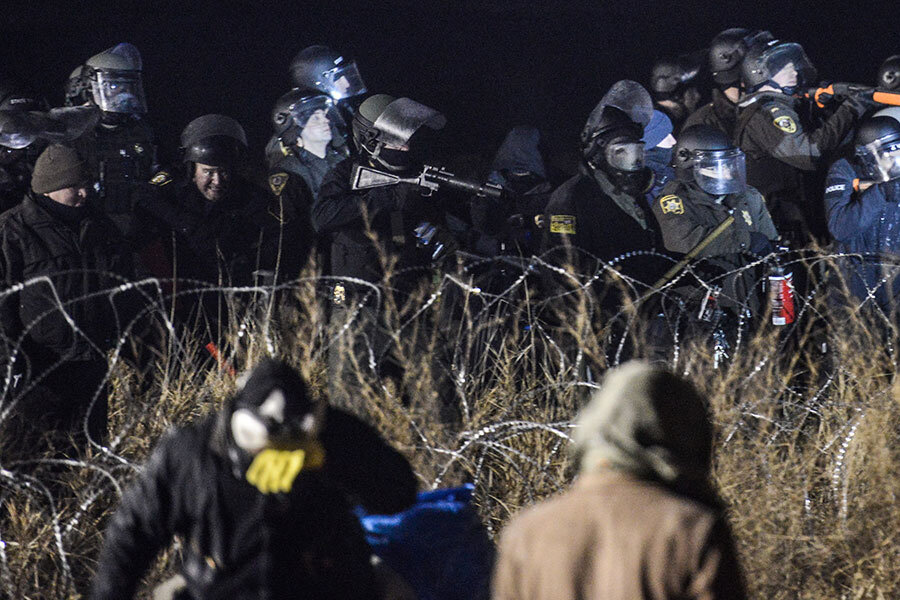At Standing Rock, police fire water cannons at pipeline protesters
Loading...
Months-long protests over a North Dakota oil pipeline came to a head in sub-freezing temperatures on Sunday night, as hundreds of protesters tried to push past a police barricade on Backwater Bridge. They were met with what appeared to be tear gas, water cannon spray, and rubber bullets, according to activist reports on Twitter and to media reports.
The upheaval began on Sunday night when protesters removed a scorched truck that had been set ablaze during a clash between demonstrators and police in riot gear in October on the same bridge, which has been closed since. The site is near the encampment where demonstrators had been for weeks opposing a $3.8 billion pipeline they say threatens to encroach on Standing Rock Sioux sacred sites and contaminate the tribe’s drinking water. Protesters set up the camp on property owned by the pipeline developer, Energy Transfer Partners; demonstrators were removed from the land by law enforcement on Oct. 27.
According to a 1 a.m. statement from the Morton County Sheriff's Department, about 100 to 200 protesters were on the bridge or nearby. It said police "had rocks thrown at them, burning logs and rocks shot from slingshots," and that one officer had been hit on the head by a rock.
Some demonstrators were reportedly also injured after getting sprayed with tear gas. Rema Loeb, 83, traveled to North Dakota from Massachusetts to join the protests two weeks ago, and he said he had to leave the bridge out of fear of being sprayed with water on the freezing night.
"It's been just horrible," Mr. Loeb told the Associated Press.
The controversy is over a portion of an almost-complete 1,200-mile pipeline that had been approved by the federal government and already built through four states to carry Bakken shale oil from North Dakota to US Gulf Coast refineries. The last bit must pass under Lake Oahe, a federally owned water source.
The Standing Rock Sioux is asking for the pipeline to be rerouted, but the project developer says that’s not possible; The pipeline is safer than sending oil by road or rail, say supporters. Kelcy Warren, the chief executive officer of Dallas-based Energy Transfer Partners, has said that the company hasn’t damaged any sites and will ensure there will be no leaks.
The pipeline construction was stalled in September so that the federal government could re-evaluate the permits required by the US Army Corps of Engineers, following a request from the tribe.
The Obama administration has not intervened in the matter and likely won’t by the end of the president’s term. It is also unlikely that President-elect Donald Trump will block the pipeline.
Mr. Trump’s financial disclosure filing in May shows investments of between $15,001 to $50,000 in Energy Transfer Partners, down from between $500,000 and $1 million the previous year. Trump also has invested between $100,000 to $250,000 in Phillips 66, an energy company that would control 25 percent of the operating pipeline, as the Guardian reported in October.
Mr. Warren, of Energy Transfer Partners, has contributed at least about $170,000 to Trump, a committee that supported him, and the Republican National Committee during the election, as The Christian Science Monitor previously reported.
This report uses materials from the Associated Press and Reuters.







